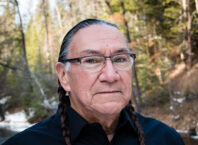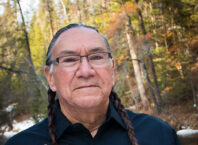Trinidad Flores was a leader. In the American Indian community of Little Earth in Minneapolis, Trinidad was widely known and highly respected. He played football, baseball and basketball. If there was a program in the community, Trinidad was involved. He circulated a petition to save the community’s Ojibwe language class. He was a role model, a friend, a brother.
“He was 14 years old when we found out that he had a heart condition,” says his mother, Cassandra Holmes. “And no one knew, not even the doctors.” Cassandra and her family learned that Trinidad would need a heart transplant to survive.
Trinidad’s story is unique, but the need for a lifesaving transplant is not. It could happen to anyone and it affects all communities. Right now, in Minnesota’s American Indian community there are 60 men, women, and children waiting for a lifesaving transplant. Which brings us back to Trinidad.
At just 14 years old, Trinidad told his mom that if anything happened to him, he wanted to help others through donation. When he received his driver’s license at 16, he registered to be a donor.
For two years, Trinidad was in and out of the hospital, waiting for his transplant. “None of us knew anyone that needed a heart transplant, so we started as a family to educate ourselves more and we prayed a lot as a family.” Then, a generously donated heart was a match for Trinidad.
“The day of Trinidad’s heart transplant surgery, he was the one comforting everybody. As he was going in for surgery he gave everybody the heart signal with his hands. Then he went in to get his new heart.”
Shortly after receiving his desperately needed heart transplant, Trinidad suffered a life-ending stroke. Once again, he had the opportunity to be a leader.
“I remember LifeSource coming to talk to us after my son’s passing, I remember the kindness and that they didn’t jump right in to talk about organ donation. They asked us how they could help us, be there for us, and sharing our sadness. They gently reminded us that Trinidad had wanted to be an organ donor. They gave us privacy as a family to talk about it. When you’re going through that kind of grief, you need that reminder that, he made a choice to help others.”
Cassandra protected his donation decision and Trinidad gave the precious gifts of his kidneys and liver to save the lives of two people.
“Trinidad passed away with his heart and his donor’s heart. We were sad to lose Trinidad but thankful that someone offered the opportunity for my son to live by giving up their loved one’s heart. As Native Americans, we felt like we needed to honor that person and take care of that person’s gift. So, they did Mide (Medicine) Ceremonies for both hearts out of respect to Trinidad and the person who donated their heart.”
Trinidad passed away four years ago, and looking back on the experience now Cassandra notes how important love and community are in her Native culture. “It doesn’t matter if you were born in the city or on the reservation, we’re here to help each other out and be there for each other.”
The need for organ donors affects everyone. Nationally, there are 120,000 people waiting for a lifesaving transplant and over half of those people come from communities of color. In Minnesota, American Indians make up about 2%of the state wait list, and .05% of the state’s organ donors.
Facts about donation
- Anyone can register to be an organ, eye and tissue donor.
- Organ donation can preserve the circle of life for up to 75 people.
- All donors are considered heroes and are treated with respect and dignity.
- Traditional burial ceremonies are still an option after donation.
- You can help someone in your community by being a donor.
What can you do?
Get the facts, and then talk to your friends and family. Helping your community – helping all communities –begins with a conversation.
For more information and resources, contact LifeSource Community Education Liaison, Lindsey Williams at 612-800-6295 or lwilliams@life-source.org.






